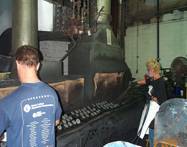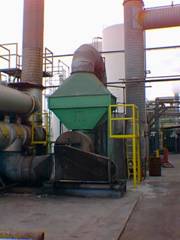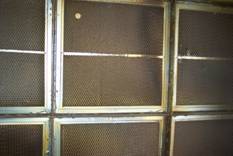abrasive
blasting
adhesion
problems
caps
and plugs
chemical
cleaning
cure
ovens
defects
fluidized
bed
hi-temp
tapes
infrared
oven
masking
outgassing
pretreatment
quality
powder selection
powder
vs. liquid
racking
spray
booth
spray
gun
substrates
tape
types
of powder
It does sound "green" to say overspray collectors keep the environment cleaner, but let's face facts; keeping the exhaust stack and fan free of overspray build-up ensures that an exhaust system can properly remove VOC's (volatile organic compounds) and other noxious vapors from a spray booth.
That is the primary purpose of a paint arrestor.
Three basic methods are used to capture overspray:
Cascade (also known as a water wash),
Baffle, and
Media filtration.


Many modern high volume spray booths incorporate one or more of these methods of source capture in an effort to improve overall removal efficiency. One of the most common combination systems, is a cascade style booth, with multi-stage media filtration, prior to the exhaust stack, or prior to a VOC control technology like an RTO (regenerative thermal oxidizer).
Anyone that looks behind the filters of a spray booth on a regular basis can probably relate a horror story or two about the condition of the plenum, stack and fan, especially booths used in high volume coating operations. The sight of all this equipment coated with paint means several things have occurred.
First, we know the fan is not operating at maximum output.
Second, we know that the exhaust capability of that spray booth is no longer meeting the air flow requirements as originally specified.
Somewhere in the past, the paint arrestors failed to achieve the required removal efficiency, or the type of coating material changed, or the operator removed a few loaded filters from the frame to keep painting until the next shift, etc. It seems as if the reasons are infinite.
Basic information for selecting the proper filtration
Every coating material exhibits properties that affect the loading characteristics in a variety of ways, depending on the source capture technology in use. Some dry in the ambient air and migrate easily. Others remain wet and sticky, and can saturate a media filter causing bleed-through. These coatings will never dry unless cured with an oven or other catalytic device.
Also, the percentage of solids in the coating and the viscosity affects the size of the droplets atomized into the air flow, and the transfer efficiency directly affects the amount of challenge the filter system must remove. Sufficient velocity to keep the overspray entrained in the air flow should also be taken into account.
Paint arrestors are typically tested with a 62% high solids enamel as the challenge aerosol. When evaluating how paint arrestors are tested it can be misleading to assume filters with the same arrestance and holding capacity will work on all coatings equally well.These same two filters may have entirely different performance characteristics on a 35% solids thermoset coating.
Even in consideration of the fact that most industrial applications still operate under the default requirement of 95% arrestance efficiency or better, a few percentage points difference can add up hundreds or thousands of pounds of fugitive emissions per year in high volume coating operations.
However, the days of evaluating filters on their paint arrestance alone are past, and application specific control technologies are being employed in single and multi-stage systems. The EPA is trending towards tighter controls of particulate emissions and that is good news.
With some basic information in hand, utilizing independent laboratory test results is a scientific approach to product selection, and performance forecasting is possible.
There are some things to be considered when using the data from test reports. A paint arrestor tested with one coating type shouldn't imply that it will perform the same on another. Fluid delivery rates and air pressure can also impact filter performance. Additionally, knowing the MERV ratings of the filter options available will provide a valuable guideline in making a selection, when requirements for the removal of specific particle sizes is part of the control technology.
Achieving Results
There are some important steps to selecting filters for an overspray application:
- Inspect the exhaust plenum, fan, and stack prior to making any recommendation
- Take note of the current style of source capture filtration and related maintenance of the equipment
- Identify the maintenance cycle for filter changes. PM, or Pressure?
- Take recordings of the average air velocity across the filter bank
- Does the current product type meet the minimum requirements? Is an upgrade necessary?
- Is the operator amenable to alternative technologies?
Ensuring the operator is aware of the latest control technologies and the negative effects of build-up in the plenum, exhaust stack, and fan is a critical part of servicing the client. Providing filtration that meets or exceeds the requirements for the application will protect the equipment from overspray contamination and maintain maximum operating performance.
Having achieved the above, the equipment remains cleaner as does the environment. It sounds green after all.
small
parts coating operation 

Overspray penetration through 1 st Stage Filter

Small RTO Unit with 2 Stage Filter System
Overspray Contamination of High Efficiency Filters in Oven Burner House

Powder Coater's Manual